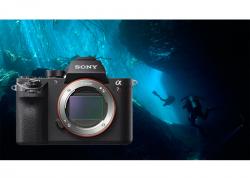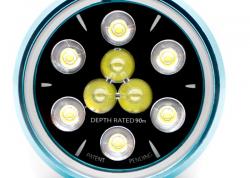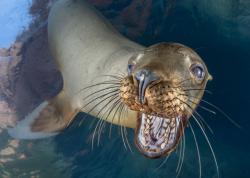Photographing Underwater Textures & Designs
Photographing Underwater Textures
Mother Nature's Amazing Undersea Designs
By Kevin Lee
Any opus produced by the world's best artists pales in comparison to the exquisite works composed by Mother Nature herself. Particularly in the underwater world, if we focus on perspectives smaller than what the average human eye "sees," an astonishing kaleidoscope of colors, textures, and designs is revealed. Most of the images that follow were taken in the waters of Anilao, Philippines, where I used Club Ocellaris as my base station. As an aside, in terms of friendly service, great cuisine, top-notch dive services and convenient proximity to the best dive sites, Club-O is the absolute best value, in my opinion (the nitrox service is the frosting on the cake).
The deep ridges of this mushroom coral cast dramatic shadows
The approach to capturing textures underwater
Fortunately with extreme macro photography, water clarity is not a serious issue since the subject-to-lens distance is so short. I always get as close to the subject as possible, often up to the minimum working distance allowed by the camera/lens setup (mine is about 4~6 inches) as long as the subject composes well. Always look at the subject, and move the camera in and out.
Underwater composition for designs
Turn the camera and explore shooting from slanted angles (not just flat, straight on), which can alter depth of field for unique perspectives. Remember getting close is not the goal, optimal esthetic composition is. But, usually the closer the better. With proper composition through the camera viewfinder, cropping can also be minimized, bringing out the greatest detail in full frame images. Finally, when coupled with optimal strobe positioning, backscatter can be largely eliminated. Strobes need not be positioned symmetrically on each side. In fact, offsetting one strobe at a different angle and/or distance than the other can produce unique shading, shadows and depth of field. Snooting, something I have yet to try, promises to add another interesting dimension to super macro images.
Crinoid arms. Normally diagonal compositions are more appealing.
The equipment used for photographing underwater textures
Equipment used for all of these underwater images was a Nikon D300 camera in a Sea & Sea housing, Nikkor 60mm macro lens, Kenko 1.4 teleconverter and dual YS-110a strobes. Strobe positioning explained here in this article, shows the extreme inward positioning of strobes for macro photography.
Underwater Camera settings
Generally I employ ISO 200 and a shutter speed of 1/250 to minimize unintentional blurring. At these close distances, the depth-of-field is very narrow to begin with, so I normally shoot at higher aperture settings (in the teens and above) to maximize DOF. If a subject is particularly light colored, I may use F32 or higher and even physically back off the strobes to achieve optimal exposure. And the power settings on my strobes are usually dialed down to 50% or less, providing just enough, not too much, light to illuminate the subject i.e. kissing it with light.
We asked Kevin some questions about whether he prefers RAW or JPEG
UWPG: Are these mainly processed from JPEGs or RAW files?
KL: All JPEGs
UWPG: Are these files cropped much?
KL: No, not much if at all. My goal is to obtain the optimal esthetic composition in the viewfinder, then snap the picture.
UWPG: Did you process these images in Photoshop?
KL: Minimally since there's hardly any backscatter and there's good control with exposure. Contrary to convention, I do not shoot RAW. I think it takes too much memory and if I can't take the image with decent exposure, then I will review the histogram and reapproach the shot. I don't have time or desire to go into a RAW processing program and edit.
UWPG: Have you had JPEGs published right out of camera?
KL: Yes, my JPEG images have made magazine front covers and inside spreads with no problems.
More of Kevin Lee's wonderful underwater texture photography
Sea Urchin
Coral
The following four images are examples of fish pectoral fins, each unique as a human finger print.
Inside of a tunicate captured using extreme side-lighting.
Even the body of a synapted sea cucumber presents an interesting and colorful design.
Sponge
Soft coral, perhaps resembling daisies.
Underside of a leather sponge.
Mollusc eggs
Coral
Tiny tunicates reveal delicate colors and designs
Mushroom Coral
Sponge pattern looks like a landscape of volcanoes on a distant planet.
A green sponge with topography resembling verdant mountains and valleys of a fantasy land.
Even common algae reveals delicate colors, patterns, and textures.
Polyps on the stalk of a soft coral.
Orange polyps on a soft coral stalk.
Colony of tunicates
A gorgeous orange and white sponge.
The texture of this sponge was the inspiration for the pattern below.
Dress, using fabric with the sponge pattern of previous image. Designed by Wendy Kaufman.
About the author
Kevin Lee is a well traveled scuba diver, an award winning underwater photographer, and an avid "brancher." More of his beautiful images can be viewed on his website at www.diverkevin.com.
More articles by Kevin Lee
Further Reading
-
Tips for Abstract Macro Shooting
-
Minimizing Backscatter
-
Improving Your Composition
-
Creative Shooting Underwater
-
Guide to Photographing Nudibranchs
Where to Buy
Please support the Underwater Photography Guide by purchasing your underwater photography gear through our sister site, Bluewater Photo & Video. Click, or call them at (310) 633-5052 for expert advice!
RECOMMENDED ARTICLES
SUPPORT THE UNDERWATER PHOTOGRAPHY GUIDE:
The Best Service & Prices on u/w Photo Gear
 Visit Bluewater Photo & Video for all your underwater photography and video gear. Click, or call the team at (310) 633-5052 for expert advice!
Visit Bluewater Photo & Video for all your underwater photography and video gear. Click, or call the team at (310) 633-5052 for expert advice!
The Best Pricing, Service & Expert Advice to Book your Dive Trips
 Bluewater Travel is your full-service scuba travel agency. Let our expert advisers plan and book your next dive vacation. Run by divers, for divers.
Bluewater Travel is your full-service scuba travel agency. Let our expert advisers plan and book your next dive vacation. Run by divers, for divers.


























































